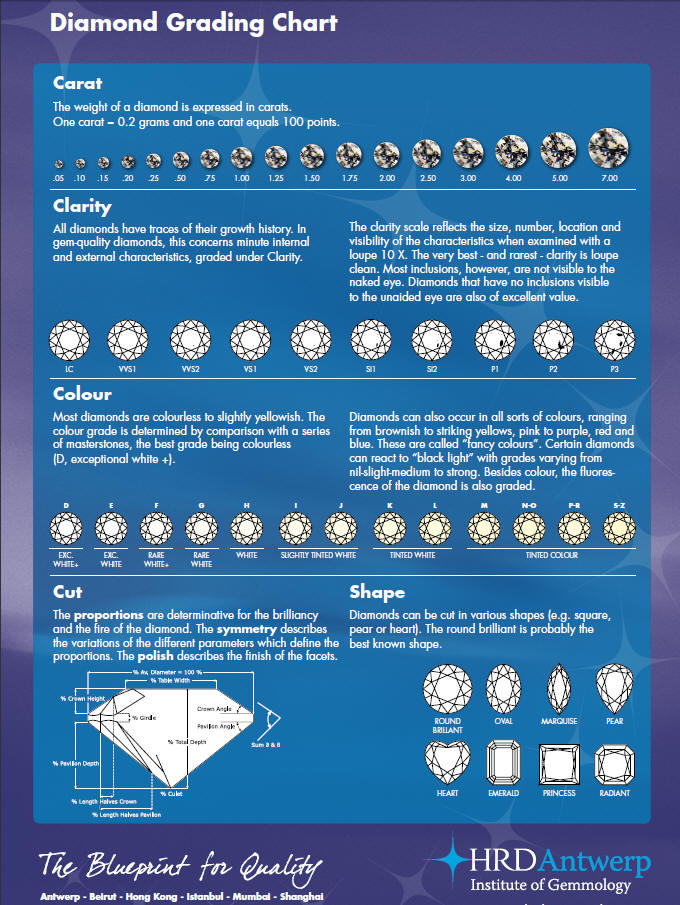
Every diamond is unique, and there are a variety of factors which affect the price of a diamond.
Various characteristics of diamonds are graded and categoried by the diamond industry. To learn about diamonds you need to understand about the "four Cs" of diamonds -- the four characteristics which are considered the most important in determining a diamond's value:
Cut - Clarity - Color - Carat
When buying diamond jewellery it is important to understand the 4Cs so that you are able to decide which to prioritise which are the most important to you.
You might decide to buy a diamond with a lower grade colour and less clarity in favour of a stone with a larger carat weight and a really good cut. Alternatively, you might focus entirely on the carat weight of the diamond, it is purely a matter of personal taste.
Understanding the 4Cs will enable you to find the right diamond for you.
Colour - GIA's diamond D-to-Z color-grading scale is the industry's most widely accepted grading system. The scale begins with the letter D, representing colorless, and continues, with increasing presence of color, to the letter Z.
Many of these color distinctions are so subtle that they are invisible to the untrained eye; however, these distinctions make a very big difference in diamond quality and price.
Clarity - Diamond Clarity Refers to the Absence of Inclusions and Blemishes.
Natural diamonds are the result of carbon exposed to tremendous heat and pressure deep in the earth. This process can result in a variety of internal characteristics called 'inclusions' and external characteristics called 'blemishes.'
Evaluating diamond clarity involves determining the number, size, relief, nature, and position of these characteristics, as well as how these affect the overall appearance of the stone. While no diamond is perfectly pure, the closer it comes, the higher its value.
Cut - A Diamond's Cut Unleashes Its Light
Diamonds are renowned for their ability to transmit light and sparkle so intensely. We often think of a diamond's cut as shape (round, emerald, pear), but a diamond's cut grade is really about how well a diamond's facets interact with light.
Precise artistry and workmanship are required to fashion a stone so its proportions, symmetry, and polish deliver the magnificent return of light only possible in a diamond.
A diamond's cut is crucial to the stone's final beauty and value. And of all the diamond 4Cs, it is the most complex and technically difficult to analyse.
To determine the cut grade of the standard round brilliant diamond - the shape that dominates the majority of diamond jewelry ? GIA calculates the proportions of those facets that influence the diamond's face-up appearance. These proportions allow GIA to evaluate how successfully a diamond interacts with light to create desirable visual effects such as:
Brightness: Internal and external white light reflected from a diamond
Fire: The scattering of white light into all the colors of the rainbow
Scintillation: The amount of sparkle a diamond produces, and the pattern of light and dark areas caused by reflections within the diamond
GIA's diamond cut grade also takes into account the design and craftsmanship of the diamond, including its weight relative to its diameter, its girdle thickness (which affects its durability), the symmetry of its facet arrangement, and the quality of polish on those facets.
The GIA Diamond Cut Scale for standard round brilliant diamonds in the D-to-Z diamond color range contains 5 grades ranging from Excellent to Poor.
Carat - Diamond carat weight is the measurement of how much a diamond weighs. A metric "carat" is defined as 200 milligrams.
Each carat can be subdivided into 100 'points.' This allows very precise measurements to the hundredth decimal place. A jeweler may describe the weight of a diamond below one carat by its 'points' alone. For instance, the jeweler may refer to a diamond that weighs 0.25 carats as a 'twenty-five pointer.' Diamond weights greater than one carat are expressed in carats and decimals. A 1.08 carat stone would be described as 'one point oh eight carats.'
All else being equal, diamond price increases with diamond carat weight, because larger diamonds are more rare and more desirable. But two diamonds of equal carat weight can have very different values (and prices) depending on three other factors of the diamond 4Cs: Clarity, Color, and Cut.
It's important to remember that a diamond's value is determined using all of the 4Cs, not just carat weight.
We are more than happy to explain this once you visit our shop to discuss your particular requirements.
E.H. Warford Jewellers 73 Devonshire Road Bexhill on Sea East Sussex TN40 1BD
©2014 E.H. Warford - All rights reserved